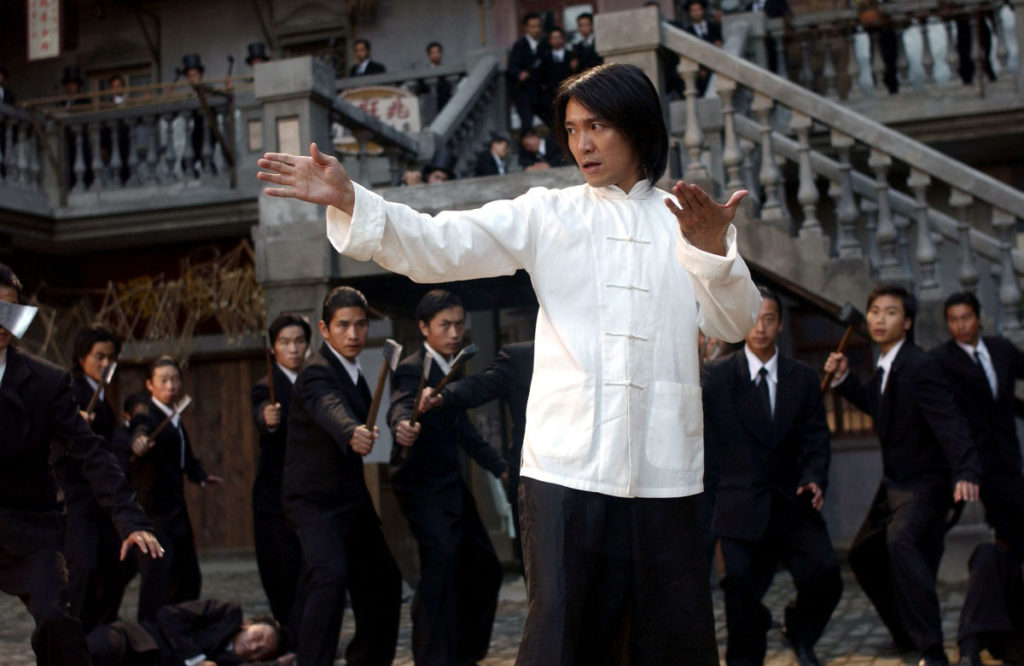
How does one do the Kung Fu Hustle? Take one part Roadrunner cartoon, mix in two parts Bruce Lee, a drop of Three Stooges and a pinch of West Side Story. Add a dash of Crouching Tiger, Hidden Dragon and a dollop of nitroglycerin. Label with subtitles. Bake until half done.
As for the plot: Who has time for a plot when there are so many movies to parody and only 90 minutes to do it in? Very loosely, when Shanghai drifter Sing realizes he’s no good at being a good guy, he tries to become a gangster, with his ultimate ambition being to join the murderous Axe Gang. Turns out he’s not very good at that, either. In the meantime, the Axe Gang, under the leadership of Brother Sum, is trying to take over Pig Sty Alley. Little does Sum realize that among the madcap denizens of Pig Sty lurk masters of various martial arts disciplines, who make Sum’s task extremely difficult. That’s when Sum calls in The Beast—the ultimate kung fu killing machine.
Nothing in this film is meant to be taken seriously, so anything “positive” is derived only obliquely. As a young boy, Sing comes to the rescue of a little girl being bullied by older boys wanting her lollipop; he pays a high price for his chivalry. As an adult, Sing realizes the full import of that lesson, which leads him to turn from his criminal ways. Sending up Spider-Man, a kung fu master tells Sing, “With great power comes great responsibility.”
Several scenes are set in a Buddhist temple. The landlady of Pig Sty Alley puts stock in casting lots in front of a Buddha statue, saying, “We’ll let Buddha decide.” Sing studies the “Buddhist Palm” method of kung fu and strives to release the flow of chi in his body. (In Eastern metaphysics, chi is thought to be the universal life force that animates all living things.) During the final showdown against The Beast, a Buddha appears in the clouds.
Director Stephen Chow makes great use of the imagery of metamorphosis—a base thing changing to become something greater and more beautiful. After an encounter with The Beast, Sing is left bandaged from head to toe in a cocoon of sorts. The camera then watches a butterfly emerge from its chrysalis before cutting back to Sing’s bandages—now empty. The “new” Sing is as different from the old as a butterfly is from the caterpillar.
A lecherous landlord tells a young woman, “Come, let me give you a physical exam.” Sing and his sidekick ogle a busty woman as she sashays past. In several scenes a man wears his pants so low that half his buttocks are exposed. While fighting, Landlady’s bosom sometimes expands to gargantuan proportions. One of the male kung fu masters flits about in an effeminate manner and is called a “fairy” by Landlady.
Kung Fu Hustle is basically a live-action cartoon, and it borrows several conventions straight out of the Looney Tunes archive. (A dust cloud envelopes a fighting throng at one point, for instance, and a chase sequence has the participants’ legs churning at breakneck speed while their upper bodies remain nearly motionless.) Such silliness doesn’t do much to diminish how extreme some of the violence is, though. People are gunned down. A man’s leg is cut off by a flying axe. Gasoline is poured over a woman and her child before a lit cigarette lighter is tossed at them (it’s intercepted in the nick of time, but the scene is beyond intense). Crime scene photos show victims of the Axe Gang, complete with weapons embedded in their bloody bodies. A man foams at the mouth as he dies after having his back broken. Another’s hair catches fire as he attempts to light a cigar.
In one “humorous” scene, Sing winds up with knives embedded in each shoulder and one arm. He is then bit on the mouth by two cobras. In a direct rip-off from The Shining, he hallucinates a torrent of blood flooding down a long hallway. In slow motion, a man’s teeth fly from his head. Another slo-mo shot shows a woman on the wrong end of a shotgun blast which sends her flying through air. The Beast points a handgun at his own head and fires (he catches the bullet with his fingers).
All that is aside from the martial arts fighting. Fists fly. Feet kick. Spears are hurled, toes are flattened, poles are smashed across heads and bodies are blasted through walls. In silhouette we see a cat cut in half (blood splatters on the wall) and a human body decapitated. A man is pummeled to the point that his head becomes embedded in the ground. Another is hit so hard his head spins around a few times before lolling backwards against his shoulder blades.
One f-word and a half-dozen s-words, all in subtitles. “A–“ is used frequently as an insult and as a direct reference to anatomy. Other interjections include “d—,” “h—“ and “b–ch.”
Landlady has a cigarette perpetually hanging from her mouth. Landlord drinks. Sum drinks, smokes large cigars, and in one scene he appears to be smoking opium.
Sing and his sidekick steal ice cream. Bullies urinate on Sing when he is a young boy (the camera focuses on his face as he’s doused). A gangster spits on a police officer he has just beaten to a pulp. The camera lingers on a man picking his nose and later on a boy with a runny nose badly in need of a tissue.
Wiley E. Coyote fails once again in his attempt to catch Roadrunner; he plunges to the bottom of a thousand-foot canyon, landing with a loud thud in a cloud of dust. We laugh. It’s just a cartoon, after all.
Moe pokes Larry in the eyes and hits Curly over the head with a giant wrench, complete with exaggerated sound effects. We laugh again. (Well, some of us do.) It’s not a cartoon, but then it’s not meant to be taken seriously, either.
Bruce Lee spins through the air, taking out multiple foes with his fabulous flying fists before landing, never breaking a sweat—or shedding a single drop of blood. He’s dead serious.
A native of Hong Kong, director Stephen Chow grew up idolizing Bruce Lee. It shows in Kung Fu Hustle, where he reverently pokes fun at the late martial arts hero. In so doing, Chow has taken the chop-socky genre and stood it on its head. Here, a man isn’t just kicked in the chest—he’s kicked and he flies across the courtyard and through a concrete wall. A fist doesn’t just land a blow, it leaves a dent. A man doesn’t just have his wrist twisted; it’s twisted to the point that his shirtsleeve explodes off his arm and his body then spins like a propeller. None of this is intended to be taken at face value, but boy is it intense.
So how much cartoonish violence is too much? And in an attempt to spoof over-the-top (and wildly fake) movie violence, can a filmmaker go too far, and ultimately produce something worse than the original? Maybe Chow is attempting to answer those questions while taking us on a supremely weird and wild ride. Then again, maybe he’s just getting his kicks at our expense.
